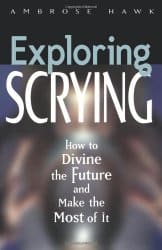
 Exploring Scrying: How to Divine the Future and Make the Most of It, by Ambrose Hawk
Exploring Scrying: How to Divine the Future and Make the Most of It, by Ambrose Hawk
New Page Books, 9781564145031, 179pp. 2001, 2009
While reading the first chapter of this book I felt as if I was being swathed in fluffy, white cotton. It struck me as being a lot like cotton candy — light, airy, but not much substance, and that fairly well describes this work. Not that this is necessarily bad. After all, it is intended as a basic, entry-level introduction to the subject of scrying.
The preparations and warnings contained in the first dozen or so pages are all a matter of common sense, which is why they bear repeating. So many people approach esoteric (to use the author’s preferred term) subjects with total disbelief, or else with a gung-ho desire to believe whatever comes along.
This author, like many of those who have been published by New Page Books, recommends the keeping of a journal. This is something I wish I had been more diligent about during the early years of my divination training. There is no substitute for being able to go back and see what you foresaw before the event and compare it with what actually transpired. Sometimes (often) you will see things that you didn’t feel were important at the time which later proved to be items of major importance. Without a journal you might continue to miss items which prove to be consistent pointers to major events. Record everything you see and experience, and review your journal frequently, and honestly. Hawk recommends three sections to each entry: what you see, how you interpret it at the time, and a review of the reading at a later date.
Like any good seer, Hawk reminds us that we do not forecast the future, only the most likely result of current trends and events. The future is not set in stone. Changes can be made through awareness and determined effort.
The reader is given practical tips for becoming more receptive to the images which constitute the end product of attempts at scrying, while avoiding the pitfalls of trying to assign universal meanings to images which may appear. The techniques are basic and as non-restrictive as it is possible for them to be.
The author reminds us throughout his work of the need to refine and hone our understanding of the symbols we encounter. We are constantly reminded to test our perceptions and to revisit our readings to see where we were right, and where we erred.
Throughout the work the need to be comfortable, both physically and with the symbols we encounter, is reinforced; as is the concept of not attempting to force perceptions, since this counter-productive. This is perceived as being essential to true scrying, and I agree with this perception. Discomfort will lead to being unsure of the source of the symbols we see, and of their interpretations.







